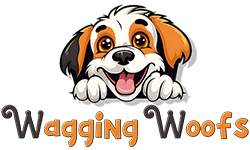How to Stop Dog from Licking Paws: Simple Home Remedies
Introduction
You are not the only one who has seen their dog lick his or her toes. Many pet owners, just like other members of society, experience the same issue, although in most cases, it is not cause for concern. A brief period of mouth contact with the paws is arguably normal, while chronic paw chewing fetches injury, risk of infection, and more alarm to the owner. Anything, that is very rightly deemed as a small irritation at times, can potentially grow to be a serious issue with time if left unaddressed.
The Foots of the dogs which are actually long slender appendages can be seen being licked by the dogs for a host of reasons. While some tend to nibble paws out of boredom or simply as a habit, some may be chewing their pads due to conditions such as allergies, dry patches, discomfort, or wounds.
The claw may also be scratched due to chemicals or allergens present in the ground. The further good news? No, in that case, panic-stricken visits to the vet are not that important. In fact, there are various other household solutions, which can aid the comfort of a foot-chewing dog and foot bring reassurance to it.
This paper will begin by elaborating the facts on: the reasons behind dogs chewing their pads and the good news is that we will provide some interesting yes, safe, and easy natural treatments to the problem so that our furry companions go about their days and don’t feel the stir to get their paws into endless licking of their pattas.
Check out our PAWSOME Merch.
Are you worried about the oral health of your dog then you must read this piece of content that discusses Coconut Oil for Dogs’ Teeth in detail.
Why Do Dogs Lick Their Paws?
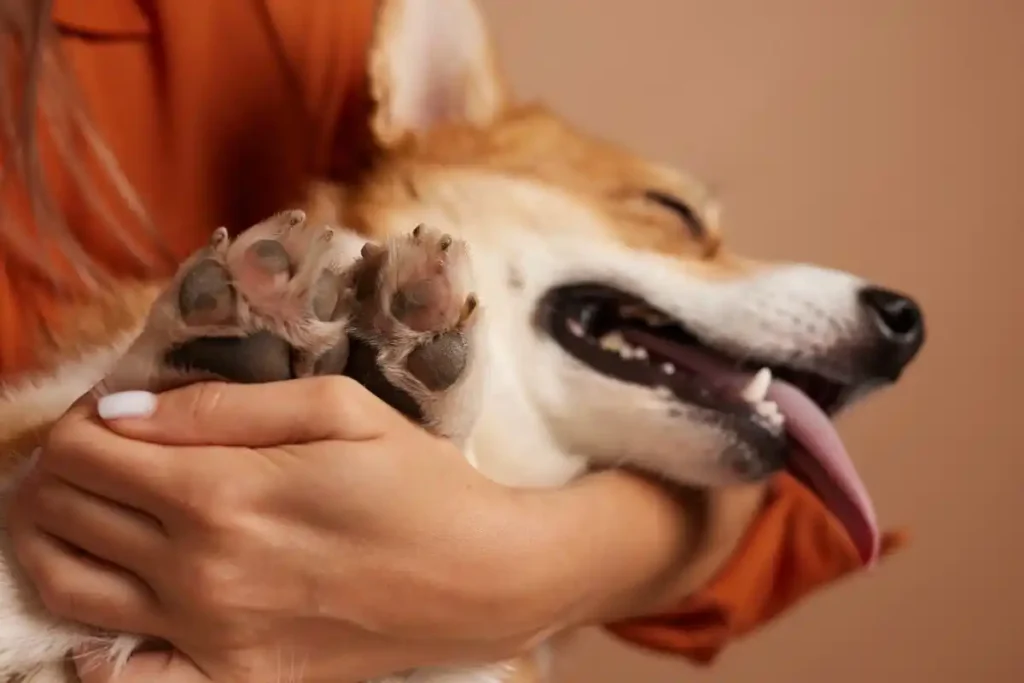
It is not unusual for foot chewing to occur in dogs now and then, especially after having a hearty meal or going out for a walk. Most of the time it is nothing to be bothered about, but for some pet owners, a particular trait might disrupt the peace in a household, in this case, that would be: over chewing.
If your dog is chewing its pads to the extreme where it appears to be compulsive, it is certainly a cause for concern. Overdoing any behavior, such as obsessive licking, may point out that the pet has some other underlying problem inherent in it, thus making it necessary to identify its origin to stop it in the future and improve the overall health of the canine.
While there could be various reasons for this behavior including stress, allergies, behavioral issues, and even genetics, several dermatological and autoimmune diseases may also come into play such as:
Dry Skin
Paw licking can be caused, for example, by dry skin. Just like human beings, canine pets too can have skin that is dry in texture. During shifts in weather conditions, most prominently during winters, paw pads get dry and develop cracks that can become very painful especially when the dog is out and about. When these or such scenarios occur, pain is inevitable, and this can cause the dogs to chew their feet out of discomfort.
Allergies
There are many reasons why a dog may nibble his claw, but one of them only dogs are prone to: allergies, Perhaps one of the more common instances of allergic reactions is the contact of dogs to airborne allergens such as pollen and dust as well as food components in diet which may prompt soreness of the skin and its surrounding areas. Whenever your dog is presented with an allergen, they may start experiencing localized itching on their forepaws which prompts rubbing of the area regularly.
Infections
In some cases, your dog may develop fungal or bacterial infections that may result in swollen, red, and very painful paws. Such infections can arise from a simple scratch or from trainer contact with germs. In most cases, females ticket especially towards canines will frequently stimulate them into chewing a particular area which can cause an infection as it continues being agitated without medical care.
Injuries
It is also almost too common to discover that minor wounds, cuts, or even surfaces such as grains of sand or gravel lodged within the dog pad area are often reasons why pups rub themselves too much. Such areas can be deemed as problematic by the dog triggering unwanted chewing. Most importantly, the area between the toes is particularly vulnerable to injuries so it’s important to check the feet of your pet often, especially after walks or playing.
Boredom or Anxiety
In some cases, the reason for the dog chewing his pad overly often can be treated as behavioral. A dog that is bored or anxious may just nibble the claw as a form of self-soothing. This is a habit that can start to form over time, especially if your dog is not receiving enough exercise or mental stimulation. In such cases, it is essential to address their boredom or stress by focusing on providing more activity and environment enrichment.
The more you understand what motivates your dog to engage in Foot chewing, the more effective the home remedy you choose will be.
Do you own a Frenchie who has an aggressive personality and you don’t understand that Why is my French bulldog so aggressive? then we have a complete article on that topic too which you may find helpful.
Inspecting Your Dog’s Paws
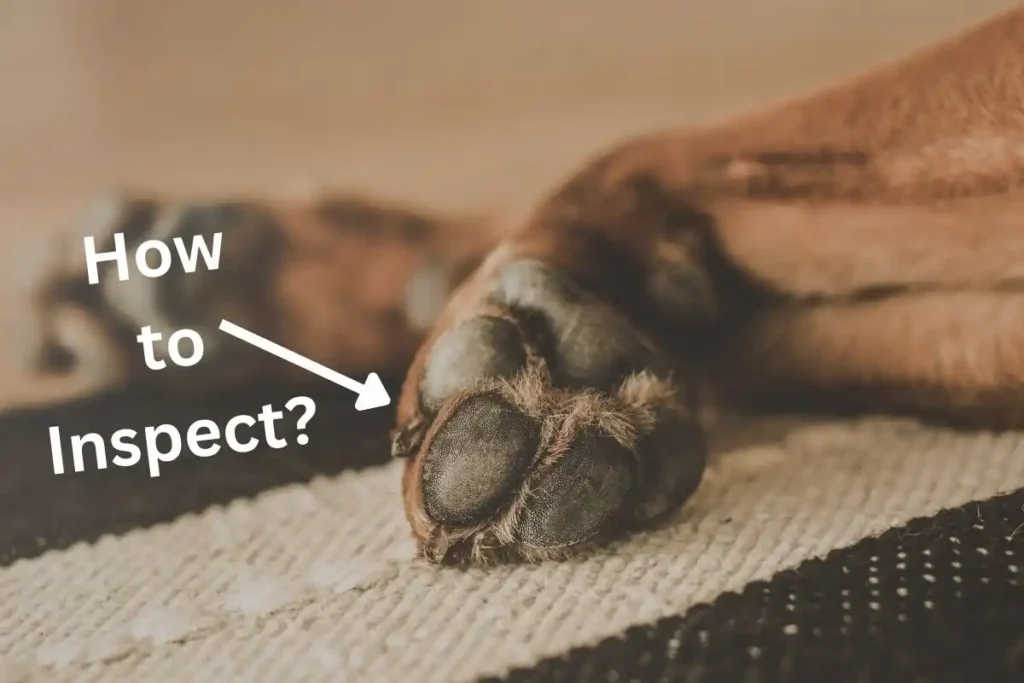
Taking your time to study dry and cracked paws before attempting a do-it-yourself home remedy is beneficial. Practicing it routinely should prevent the cause behind the licking from ever being chronic because grooming should never be compulsive, always an evocation of an event. Read this simple guide explaining step-by-step instructions on how to perform a dog claw inspection at home.
Step 1: Start by Calming Your Dog
The most important step for all patients is relaxation. With a treat in one hand and Dealle on the other, hold one claw of the dog to prevent movement. Many pet owners will say that this is the best treatment because it puts one’s mind at ease.
Step 2: Check for Visible Wounds or Cuts.
Underneath the dryness of the paw’s surface skin, evidence of any cutting or bruising similar to surface pain is the strongest of red flags. Cuts are easily sustained when trodding across rough spirit and sharp surfaces. Small cuts may not draw attention, but they are big liars because these small cuts can trigger incessant chewing and lead to an abusive situation.
Step 3: Inspect Between the Toes
Carefully examine the spaces between your dog’s toes. Sometimes, foreign objects like tiny pebbles, grass seeds, or splinters can get stuck there, causing agitation. Always inquire about your dog’s nibbling habits and impulses, as they will provide the strongest hints and assistance in the search of abnormal events and occurrences.
Step 4: Are There Any Signs of Swelling Or Redness?
If swelling or redness is noticed, that can point to an infection, inflammation, or a sensitivity reaction. This is especially true for licking performed by your dog frequently. Areas of skin that appear to be overly puffy or red should be watched closely.
Step 5: Inspect the Paw Pads.
The dog pads should be observed for signs of dryness or change in skin color, or it should have cracks. It is, however, crucial to avoid allowing the dog pads to dry and become cracked as they cause a lot of discomfort to the animal and cause it to develop the habit of shredding its skin. Make sure there are no signs of illness or injury, especially when the pet has been out of doors and perhaps walking on the ground.
Step 6: Smell Test
Your dog should never have any unusual smell about him or her. Sore-appearing or foul-smelling discharge from the toe of a dog could be a sign of fungal or bacterial infection. No panic though, if your canine’s claws look eerie or off, the dog may need the services of a vet.
Key Symptoms for Investigation
- Cut or Scrapes: Small wounds, mostly due to damage and that can cause irritation even if they look minor.
- Redness or Swelling: A common feature across all diseases, indicates infection or redness of the tissue.
- Foreign Object/Peebles/Others: Stones, sand, and mud between the toes of the dogs due to playing outside.
- Dry or Cracked Pads: Such conditions could be due to dry skin or dry weather.
- Unpleasant Smell: A potential sign of infection. May point towards an infection in these parts of the claw or nails of the dog. Looking deeply into your dog’s forepaws more often will enable you to treat the problem before it is serious because it will enable you to prevent your dog from nibbling its pads excessively.
If the source of the nibbling is identified, natural treatments are possible, and if need be after consultation with a veterinarian.
Best Home Remedies to Stop Dogs from Licking Paws
In this case, possible natural cures are not many but exist, and they may be helpful when your dog chews its paws frequently. Some of the treatments that have come out as very effective are discussed below: By use of apple cider vinegar, chamomile tea baths, etc. The most appealing feature of these remedies is that they would soothe the soreness and other problems to the claws and prevent further licking while leaving out chemicals.
Apple Cider Vinegar Soak
Due to having antifungal and antibacterial properties, it is no surprise that apple cider vinegar is a brilliant cure for doggy foot discomfort infections and irritant allergies.
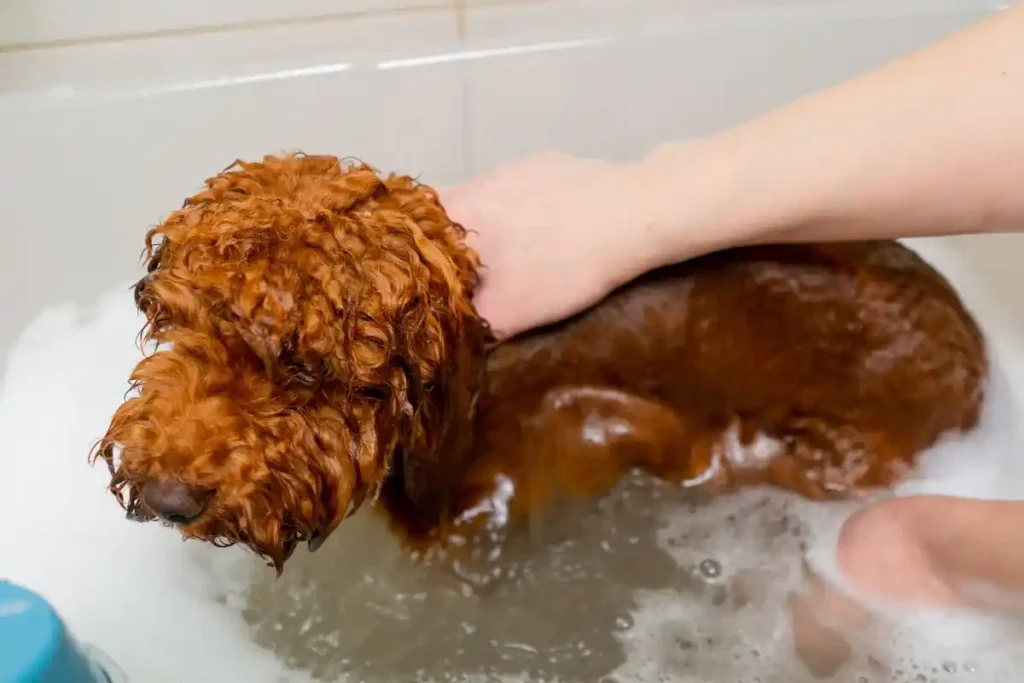
How to Dilute for Safe Use
While apple cider vinegar can assist in paw irritation, sufficient concentration should be used. The perfect ratio is one part vinegar to two parts fresh water.
Steps for Application
- Prepare the Solution: add one cup of apple vinegar and two cups of water and put them in a basin.
- Soak Your Pup’s Paws: Take your dog and dip his paw in the solution making sure that they stay in there for about 5-10 minutes.
- Dry Thoroughly: The wiped area must be clean, and extra attention needs to be given to areas around the toes particularly the space between them.
- Frequency: This soak should be taken 2-3 times a week or every time possible until positive changes are observed.
Coconut Oil Spray
Moisturized animals’ and anti-inflammatory agents such as coconut oil naturally hydrate and replenish dry or cracked dog-paw-pads of dog. In addition, it results in a moisture-locking barrier.
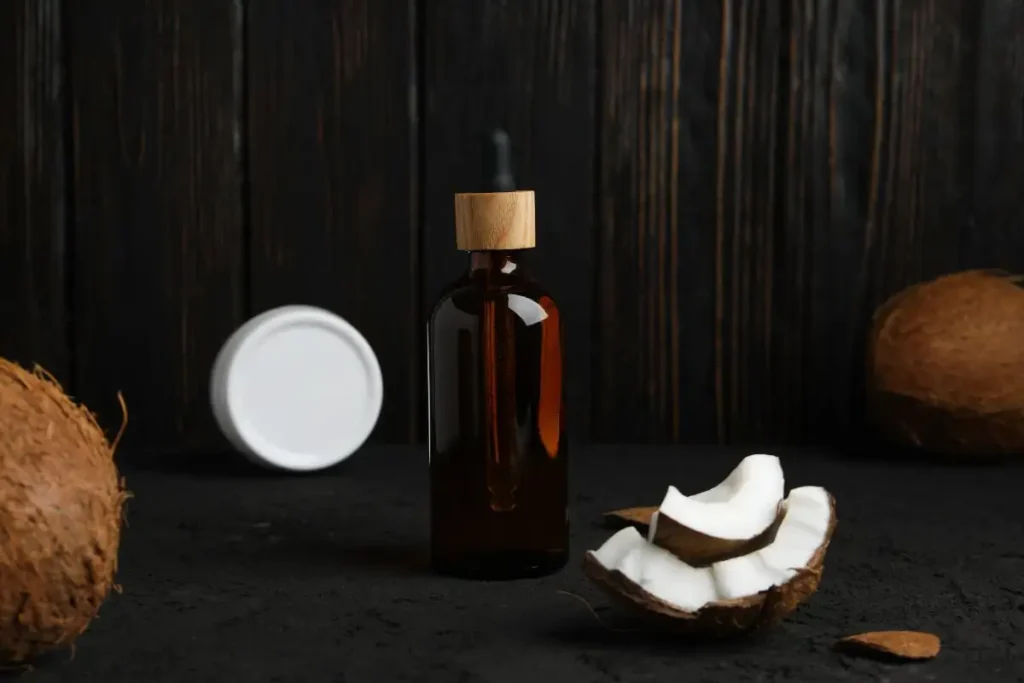
How to Use
Take small portions of coconut oil and warm them in your hands before rubbing the substance on your dog’s Footpads. Otherwise, mist the hurt areas using a spray bottle.
Benefits
- Moist and rehydrate the dry and cracked paw pads.
- redness and discomfort are reduced.
- Further erosion of the tissues is also prevented by the protective layer.
Does your canine suffers from constipation then you might find this blog post very help that covers Coconut Oil for Dog Constipation. It is a Natural Solution for Your Furry Friend.
Oatmeal Bath
With its soothing effects, oatmeal is often recommended for dogs suffering from itchy or irritated skin as it acts as a gentle agent.
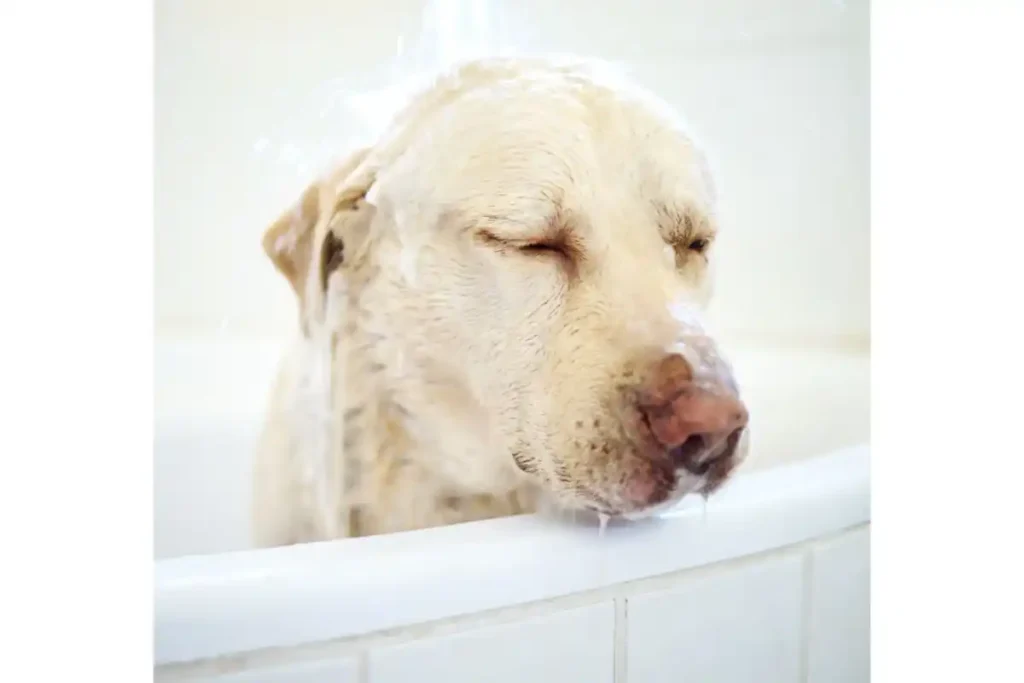
Instructions
- Prepare the Oatmeal: Measure out a portion of plain and unsweetened oat flakes and process the grains to a fine dust.
- Prepare the Bath: To room temperature water that is either in a tub or basin, add the oatmeal powder and stir until it is completely dissolved.
- Put Your Dog in the Bath: Allow your dog to stand in the oatmeal bath for 10-15 minutes.
- Wash Off and Dry: Wash off the excess oatmeal and dry the paws of your pet.
An oatmeal bath is specifically good for dogs with Immune reactions, chronic or acute, in which they will greatly benefit from having their skin discomfort relieved as well as the intense itching sensation reduced.
Baking Soda Soak
It contains enormous amounts of Sodium & calcium, which get absorbed deeply into the inflammatory channels meaning that your dog will benefit from it in a number of Immune reactions that it may be experiencing.
Step-by-Step Instructions
- Dissolve the ingredients: Combine 2 tablespoons of baking soda and the amount of warm water that will fill a gallon container.
- Immerse the Paws: Dip your pup’s paw into the solution and it should be soaked for 5-10 minutes.
- Blot the Paws: Pat your dog’s claws as dry as possible to reduce the chances of them soaking up any moisture after application.
Benefits
The baking soda solution facilitates the immobilization of allergic agents that may be present, reduces edemas, as well alleviates redness or hot areas on paws.
Chamomile Tea Soak
If your dog is having some inflammation, then chamomile tea is among the very best teas that you can give your canine buddy, and as I said earlier, all its anti-inflammatory properties are well-accommodating to remembered and irritated ones.
How to Use
- Brew the Tea: Put two or three chamomile tea bags in hot water and let it stand for approximately two or three minutes until the tea cools down.
- Immerse the Paws: Submerge the feet of your dog in the chamomile tea you have prepared for anything between 5 and 10 minutes.
- Dry Off: After doing the soaking, use a part of a towel to dap on the feet of your dog.
Benefits
Chamomile tea has a calming effect on the skin and must reduce any inflammation and aid in giving quick comfort to itchy paws.
Check out our PAWSOME Merch.
Additional Tips for Preventing Paw Licking
Although home therapies can treat paws that have already become irritable, doing all necessary to avoid the cause of the problem is equally, if not more, important. The chances of your puppy nibbling its pads a lot in the future can be considerably lowered by changing some aspects of your dog’s nutrition, grooming regimen, and protective measures.
Nutrition Adjustments
A dog’s nutrition has a direct impact on its skin or even paw health. Most cases of allergies or rough skin are the consequences of what the dog consumes, and so only the correct foods should be introduced while the allergens are completely removed.
Things to Include and Things to Exclude
For owners whose dogs have any symptoms of dry skin or allergies, it would be prudent to include omega-3 fatty acids from fish or flaxseed oil. These oils act to lubricate their skin and reduce the levels of inflammation. Any food made from common allergens such as soy, corn, or wheat often leads to skin complaints, and consequently, Foot chewing should also be avoided.
Grain-Free or Hypoallergenic Dog Food
Food sensitivities can be managed through the transition of your dog to a grain-free or hypoallergenic diet. For some dogs, food Intolerances could be causing itchy spots, and they might be able to benefit from some specialized dog food designed to prevent allergic responses. Speak to your vet before making any big changes in your dog food replacement so as not to make your dog malnourished.
Regular Grooming
In order to avoid further irritation that could cause licking, it is necessary to maintain your dog’s feet clean and free of excessive hair.
Trimming Nails and Fur
Constant licking can result from nails and hair that is long and bushy in the dog’s toes, so now you know why weekly bathing is important! A dog’s nail will hurt if too long, so nail clippers should be handled carefully. In addition, reduce the amount of hair growing around their toes so that it does not cause tangling and dirt or other harsh material doesn’t build up around their claws and cause agitation to the surface of the skin.
Application of Paw Balm
Always apply Olive Dog Balm or any dog paw Ointment for that matter after taking the dog outside and you’re sure that there will be no hopping or bouncing. Your dog will love you for this and get into the habit of not entertaining the behavior before your next adventure.
Benefits of Paw Balm
When applied to dry canines’ claws, paw balms can effectively prevent moisture loss and act as a lubricant for the Foot pads that might be exposed to harsh weather conditions during winter or hot pavements in the summer. If a dog has paw Ointment regularly applied, it keeps the Foot pads intact and smooth and further prevents the pet from excessive licking that may cause cracks.
How to Apply and When to Use
To maximize the effectiveness of the balm and to ensure that the dog is protected at all times, the ointment should be applied before leaving the house. Alternatively, it can also be applied after a dog has been groomed which would minimize outside endeavors of the animal. There is no set time for paw Ointment to be applied as it can be used whenever necessary during walks outside.
Use of Dog Booties
Regardless of size, the cuteness of a shoe shouldn’t overshadow its practicality. Dog booties serve as a barrier preventing external elements from coming into contact with the paw while also minimizing the chances of the feet being injured, Chew proof dog boots are often made durable – a perfect combination for a dog in training.
Protecting Your Dog’s Paws
To protect your paw from rough terrain, scorching pavements, or extreme weather conditions, a boot can be worn to ensure safety and give comfort. Not only do booties provide padding for the paw from outside influences but they also assist in protecting from allergens that may be inhaled or obtained from the ground.
When and How to Use Dog Booties
You may want to consider taking your dogs out into booties if it’s too cold or too hot or they are going for a rough walk on the rough areas outside the moderate. Care must be taken that the booties are not too tight and are also porous so as not to hash in moisture that may lead to infections. Get your dog used to booties by first and foremost getting them to wear the booties indoors before going outdoors.
When to Visit the Vet
You can effectively resort to DIY remedies and treat most cases of licking issues on your dog’s paw, but at some point, paw-licking issues require looking for professional assistance. You need to know when a vet appointment is necessary regarding your dog’s foot grooming issues.
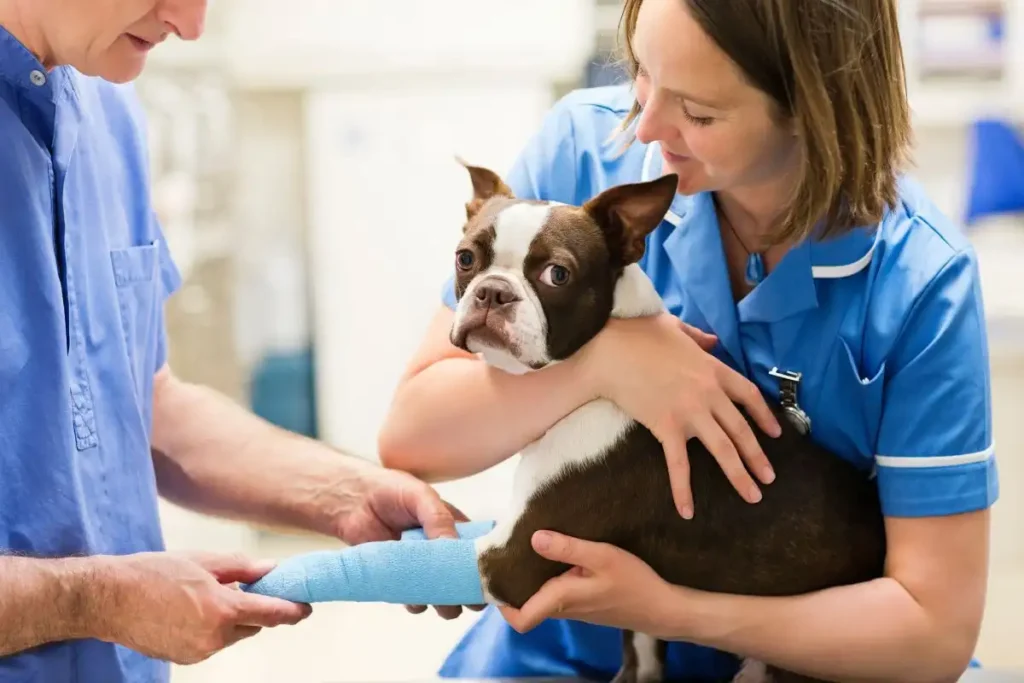
Signs That Require Professional Attention
- Continuous Paw Licking: If your dog chews its claws persistently no matter how many anti-lick products you try at home, there might be variations that are above the normal and require appropriate medical attention.
- Persistent swelling, redness, and bleeding: Swelling, redness, or bleeding in the paw area should be reported to a veterinarian as soon as possible. These can signal infections or diseases that, if neglected, can put you at serious health risk, and hence a quick visit to the vet is required.
Timely diagnosis and intervention of serious or chronic conditions can help your dog get proper attention and eliminate any chances of future problems. This would help your furry friend quickly recover to their happy self.
Are you Curious about Can I Use Vaseline on My Dog? Here’s What You Need to Know.
Conclusion – How to Stop Dog from Licking Paws
To conclude, natural methods can be very helpful to stop your dog from licking its paws. These home remedies soothe the skin and prevent further licking from apple cider vinegar soaks to applying coconut oil, among many others. But, pet owners can help themselves by preventing their pooches from licking too much by keeping an eye on them and figuring out what else might be making them lick tacky’s more than usual.
Although home treatment is very effective and should be the first course of action, it should be followed up with a visit to the vet no matter how occasionally time is, if the concern continues. Take note that dogs can be quite stubborn, but with prompt diagnosis, your dog can remain fit. Understanding how to stop dogs from licking claws using DIY remedies is perfectly fine, but it should be regarded as an early preventive measure and seldom the final treatment.
FAQs
1. Is paw licking in dogs normal behavior?
Well, I have to clarify that licking the paws is perfectly natural for dogs, to some extent. They may lick their paws just because of cleaning themselves or when they are targeting minor itch or injury. But in some circumstances, grooming excessively makes it clear that there is a problem to be addressed somewhere.
2. What are the common causes of paw licking in dogs?
There are six main reasons behind paw licking; the first one is, food allergies or environmental sensitivity, the second is, skin itchiness due to dry skin, the third is, bacterial or fungal infection on the paw, the fourth is, wounds on the paw, and last but not least, boredom or anxiety. Understanding the cause allows for a cure of the same, thus it is important in developing treatment strategies.
3. Can I use regular lotion on my dog’s paws?
Do not apply normal human lotion on the paw of the dog as most of the products have contents that are bad for them. In its place, you should use paw balms or moisturizers which are made for pets or especially for dogs.
4. Can stress and anxiety cause paw licking in dogs?
Stress and other forms of anxiety in dogs can actually cause a dog to over-lick its paws. For them, it is always something of a way to wind down. Such actions as creating an environment that is free from disturbing stimuli, and stabilization of the source of stress may decrease this behavior.
5. What can I give my dog to stop licking his paws?
You can make soak baths using apple cider vinegar, coconut oil, or oatmeal baths to calm the itchiness. Besides, it is possible to try using paw balm, as well as replacing the normal shop-bought food with a hypoallergenic one. If this continues, get advice from your veterinarian.
Sources
